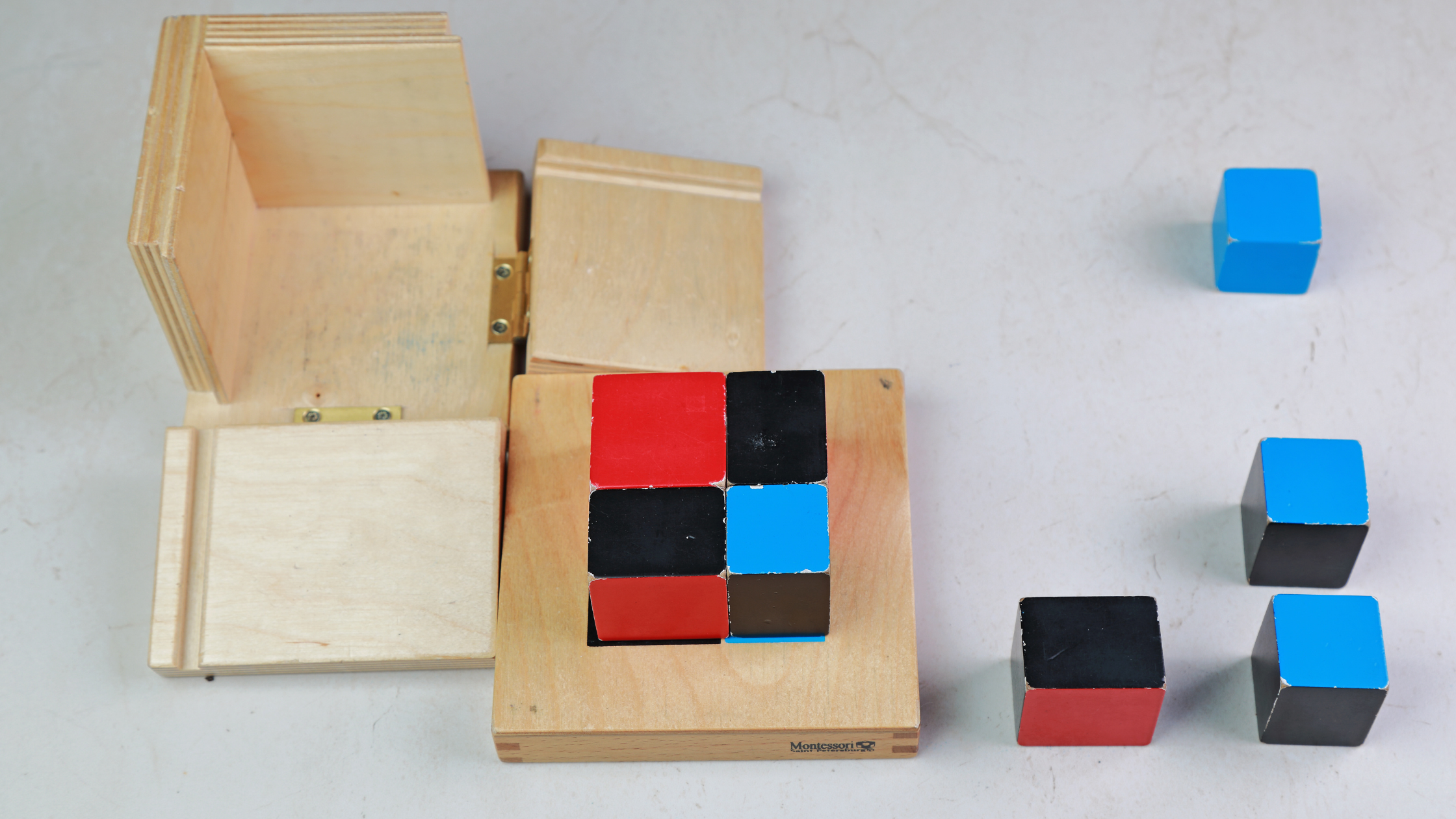Do you wonder if a 4-year old child can learn some algebraic expressions? Yes, they can. Montessori binomial and trinomial cubes are two such sensorial materials in Montessori education that could help a child learn allergic expressions without much hassle. The Montessori Binomial Cube is an iconic educational tool designed by Dr. Maria Montessori to foster a child’s understanding of spatial relationships, algebraic equations, and mathematical concepts.
What is a Montessori Binomial Cube?
A binomial cube consists of eight wooden blocks in varying colours and sizes that fit together to form a cube. The 8 wooden blocks include one red cube, one blue cube, three red and black matching prisms, and three blue and black matching prisms.
Each block represents a mathematical expression of the binomial theorem (a + b) ³. It offers the children to explore and discover the relationships between different dimensions and quantities in hands-on manner.
The children build their skill and depth perception while correctly building the cube inside the box. Through the manipulation of the blocks, children engage in a sensorial experience. This fosters problem-solving, logical thinking, and a deeper grasp of abstract mathematical concepts.
Benefits of Montessori Binomial Cube
The goal of the material in the early stages is to challenge a child’s ability to identify patterns and relationships between the blocks rather than to focus on the intricate mathematics behind the material.
This knowledge serves as a foundation for more advanced mathematical ideas like algebra and fractions. In the elementary years, if the child’s education follows the Montessori Method, they will utilise the binomial cube to comprehend and engage with algebraic concepts.
The Montessori Binomial Cube offers a range of benefits for children as they engage with this educational tool.
- This cube helps the children comprehend mathematical concepts in a tangible way making complex ideas simpler.
- Assembling the cubes promotes the problem solving skills, logical thinking, and spatial reasoning in the child.
- Handling the box, the cubes, and the prisms enhances the fine motor skills along with hand-eye coordination.
- As children solve the puzzle and successfully complete the cube, it boosts their confidence, resilience, and willingness to tackle challenges.
- It sparks curiosity and encourages a love for exploring and understanding mathematical principles in a playful and engaging manner.
Presentation of the Montessori Binomial Cube
It is best to let the child perceive the binomial cube as a three-dimensional puzzle so that they can concentrate on the pattern and spatial relationships rather than the mathematical formula.
- Invite the children to the table in small groups.
- Take off the box’s lid to reveal the finished cube’s painted surface facing upward.
- Carefully remove each block from the box one at a time by pulling down one side at a time.
- Arrange the blocks according to colour. To ensure that the colour is seen clearly, make sure to leave an inch of space.
- Explain the concept to the child, using the box lid, and start with the red block first.
- Indicate that the block must match this colour by pointing to its red side.
- Spot a matched block and set it in the appropriate place.
- Keep working in this way until the initial level is finished.
- The top pattern ought to line up with the box’s lid.
- Show to the children that the first level is flat by placing their hand on it.
- Now instruct to place this layer inside the box.
- After the first level is inside the box, start the second level on top, referring to the box lid.
- Allow the children to assist if they have recognized the pattern.
- Once the second layer is finished, demonstrate to the child that it is flat once more with a hand.
- Close the box, side by side and place the lid at the end.
Exercises for the Montessori Binomial Cube
Here are some ideas that educators can use to help the children understand the concept of this cube.
Exercise 1 – As stated in the section of Presentation, allow the child to work individually on the Montessori binomial cube. Assist if needed.
Exercise 2 – Set up the box as stated in the presentation and invite the child. To the right of the box, remove all of the cubes and prisms and group them together.
After that, close the box and set it aside. As in the presentation, assemble the binomial cube, but this time without using the box. After finishing, mix the prisms and instruct the child to construct it, outside the box.
Exercise 3 – Build the binomial cube again, following the steps in Exercise 2. After it is constructed outside of the box, cut the cube in half vertically. Turn them to show the child that they are the same. After the cube has been reformed by joining the halves, carefully remove the top layer and place it next to the bottom layer to demonstrate how similar they both appear. Have the child separate the layers after replacing them.
Final Words
One of many sensorial lessons that indirectly prepares the child for mathematics is the Montessori binomial cube. It’s the ideal illustration of how Maria Montessori brought concrete learning into the picture before abstract learning. The Binomial Cube is much more than a teaching tool; it represents the spirit of Montessori education. This allows children to think at their own speed, develops a lifelong love of learning, and builds a strong foundation for mathematical comprehension. Children who interact with this cube not only learn important life skills but also mathematical concepts, laying the foundations for a journey of ongoing learning and development.

